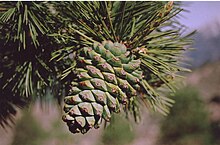Pinus gerardiana
| Chilgoza pine | |
|---|---|

| |
| Pinus gerardianafemale cone | |
| Scientific classification | |
| Kingdom: | Plantae |
| Clade: | Tracheophytes |
| Clade: | Gymnospermae |
| Division: | Pinophyta |
| Class: | Pinopsida |
| Order: | Pinales |
| Family: | Pinaceae |
| Genus: | Pinus |
| Subgenus: | P.subg.Strobus |
| Section: | P.sect.Quinquefoliae |
| Subsection: | P.subsect.Gerardianae |
| Species: | P. gerardiana
|
| Binomial name | |
| Pinus gerardiana | |
| Synonyms[2] | |
| |
Pinus gerardiana,commonly known as thechilghoza pineorneja,is apinenative to the northwesternHimalayasinAfghanistan,northern Pakistan,Waziristanand northwesternIndia,growing at elevations of 1,800–3,350 metres (5,910–10,990 ft).[1]It often occurs in association withCedrus deodara,[3]andPinus wallichiana.
Description
[edit]Thetreesare 15–25 metres (49–82 ft) tall with usually deep, wide and opencrownswith long, erect branches. However, crowns are narrower and shallower in dense forests. Thebarkis very flaky, peeling to reveal light greyish-green patches. Thebranchletsare smooth and olive-green. Theleavesare needle-like, in groups of three, 6–10 centimetres (2.4–3.9 in) long, and spread stiffly. They are glossy green on the outer surface, with blue-greenstomatallines on the inner face; their sheaths fall in the first year. Theconesare 10–18 centimetres (3.9–7.1 in) long and 9–11 centimetres (3.5–4.3 in) wide when open, with wrinkled, reflexedapophysesand anumbocurved inward at the base. Theseeds(pine nuts) are 17–23 millimetres (0.67–0.91 in) long and 5–7 millimetres (0.20–0.28 in) broad, with a thin shell and a rudimentary wing.[3]
Similar species
[edit]P. gerardianais similar to the closely relatedlacebark pine(Pinus bungeana), another pine with flaking bark. However,P. gerardianahas denser, longer, and more slender needles, as well as larger cones thanP. bungeana.[4]
Taxonomy
[edit]The scientific name commemorates CaptainPatrick Gerard,aBritisharmy officer of theBengal Native Infantry.[4]who collected it during a 1823–25 military survey in India.[3]
It was first published in A.B.Lambert, Descr. Pinus, ed. 3, 2: 144 bis in 1832.[2]
Distribution and habitat
[edit]P. gerardianais native to Afghanistan,Tibetin China,Jammu-Kashmirin India, and Pakistan.[2]Since it grows at high, mountainous altitudes, it inhabits valley floors in between high mountain ranges in theHimalayas,tending to grow among open vegetation on dry, sunny slopes.[1]
Conservation
[edit]In 2011, this species was listed as near threatened on theIUCN Red List of Threatened Species.It was previously listed as Lower Risk/near threatened in 1998.P. gerardinaforests have declined by an estimated 30% due toconversion of pine forests to farmland,intensive grazing,andoverharvestingof the seed cones and timber forfirewood.[1]The Himachal Pradesh State Forest Department has triedartificial regenerationof chilgoza pine at many places. However, performance of seedlings was found to be very poor.[citation needed]

Ecology
[edit]Since their seeds do not have a wing capable of enabling effective dispersal by wind, the seeds ofP. gerardianaare dispersed by birds.[1]TheEurasian nutcracker(Nucifraga caryocatactessubsp.multipunctata) is one such species that does so.[3]
P. gerardianais also a secondary host forHimalayan dwarf mistletoe.[5]
Uses
[edit]Older trees that don't produce enough cones to harvest pine nuts from are felled for firewood. The wood is also used for local light construction and carpentry.[1]
Food
[edit]Chilghoza seeds, orpine nuts,are harvested for consumption in autumn and early winter by knocking the cones off of the trees. The trees and seed harvesting rights are owned by local mountain clans and villages in some areas, from which they may be exported to markets in the northern Indian plains. In traditional harvesting practices, enough seeds are left behind for the forest to regenerate, but in areas controlled by private contractors, all cones are harvested.[1]
Chilgozapine nutsare rich incarbohydratesandproteins.The seeds are locally referred to and marketed as "chilgoza", "neja" (singular) or "neje" (plural). Chilghoza is one of the most important cash crops of Afghanistan,[6][7][8]as well as ofKinnaurandPangi ValleyofChamba districtofHimachal Pradesh,India.[9]They are sold at approximately $20–$53 per kilograms in India.[citation needed]
References
[edit]- ^abcdefgFarjon, A. (2013)."Pinus gerardiana".IUCN Red List of Threatened Species.2013:e.T34189A2850009.doi:10.2305/IUCN.UK.2013-1.RLTS.T34189A2850009.en.Retrieved15 February2023.
- ^abc"Pinus gerardianaWall. ex D.Don | Plants of the World Online | Kew Science ".Plants of the World Online.Retrieved30 October2023.
- ^abcdEarle, Christopher J., ed. (2018)."Pinus gerardiana".The Gymnosperm Database.
- ^abDallimore, William;Jackson, Albert Bruce(1923)."Pinus".A handbook of Coniferae, including Ginkgoaceæ(1 ed.). New York: Longmans, Green & Co. pp. 357–470 [396–397].doi:10.5962/bhl.title.15657.
- ^Hawksworth, Frank G.; Wiens, Delbert (April 1998).Dwarf Mistletoes.DIANE Publishing. pp. 264–265.ISBN978-0-7881-4201-7.Retrieved16 April2022.
- ^ZS (6 November 2022)."Pine Nuts Export Hike Increase in World Market".Bakhtar News Agency.Kabul, Afghanistan.Retrieved3 January2023.
- ^"Afghanistan Exports At Least 5,000 Tons of Pine Nuts".TOLOnews.4 January 2023.Retrieved4 January2023.
- ^"China largest importer of Afghan pine nuts: MoCI".Pajhwok Afghan News.Kabul, Afghanistan. 3 January 2023.Retrieved3 January2023.
- ^"Challenge to save Chilgoza & wild mushrooms in HP".United News of India.22 June 2018.Retrieved14 February2023.

